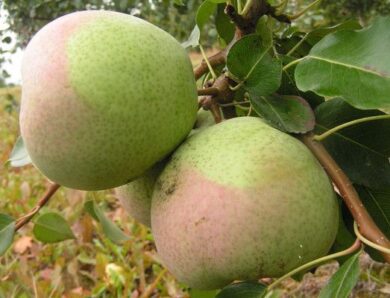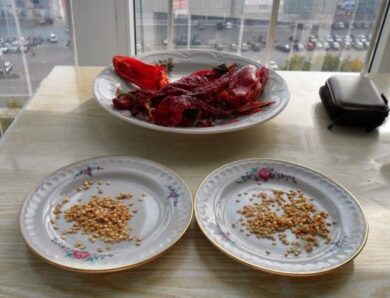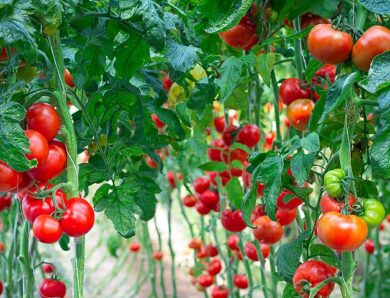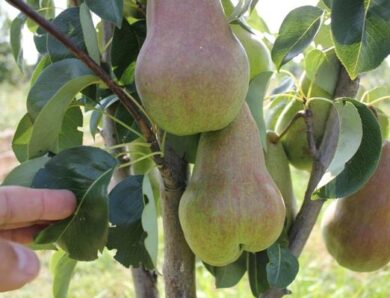Pear Forest Beauty: description and characteristics of the variety
Forest Beauty Pear is an ancient and extremely popular Belgian variety among domestic gardeners.. It is famous for its unprecedented yield and excellent dessert taste of the fruit. The variety is unique in its theme, which is not an achievement of selection. These trees were discovered by chance by a traveler Chatillon in the wooded area of Alost (Belgium) at the beginning of the XIX century, then were actively distributed in the gardens of Europe and other continents.
Description and characteristics
The description of the variety should start with that, that Forest Beauty is a very promising pear. Its seedlings have been used many times in breeding work and now more is known 30 new, including columnar species of pears, bred on the basis of Forest Beauty. During its history, the variety has changed several names. It was originally called "Forest Pear", later - "Flemish Beauty", in honor of the Flanders region (Belgium), where the tree was found.
And then the name "Forest Beauty" became attached to him., that has survived to this day. The trees of the Forest Beauty are not too tall (to 5 m), neat, have a wide, but a flat pyramidal crown of medium density. Shoots are strong, dark brown color, with a small amount of tested lentils, from the edges slightly drooping. Leaf plates oblong, bright green, with minor notches on the edges. Pear blooms in mid-April. The flowers are small, pink shade, have high resistance to temperature changes and are not damaged by rotary frosts.
Cold resistance is a hallmark not only of flowers, but also trees. Pear variety Forest Beauty easily tolerates low temperatures in the northern regions, where the thermometer in winter drops to -45 °C. Immunity to fungal diseases is low. At the lowest humidity trees are affected by scab, different types of rot, less rust and powdery mildew. The variety is partially self-fertile. To increase yields, it is recommended to plant next to pollinators - pear varieties of Lemongrass, Williams.
The fruits of the Forest Beauty are valued for their unsurpassed taste and attractive appearance. They are aligned, beautiful ovoid shape, medium size (150-170 G), however, single specimens can reach large sizes. Known cases, when in the upper part of the crown ripened pears weighing about 300 p. The skin is thin, but dense, with a slight roughness. As it matures, its color changes from greenish-yellow to golden-amber. On one side, facing the sun, an intense blush appears.
The flesh of the pear is white with a slight cream tinge, fragrant. The structure is delicate, soft, at full maturity oily, with a high juice content. The taste is dessert, very sweet, with a faint sour taste. Saucer negligible, the heart is outlined with stone formations, seeds are large, brown. Pears do not last long, but the stages of full ripening are the best among dessert varieties.
Features of cultivation
Agricultural techniques pear Forest beauty is simple, but has some features. These unpretentious trees do not have high soil requirements. Suitable for them as moderately moist, and relatively dry land, however, growing in fertile and loose soil, they develop better and bear fruit.
The best time to plant seedlings is spring, in the period from mid-April to mid-May, when the snow is completely gone. The best place for planting will be sunny, slightly blown by the wind area on a small hill. In this place, moisture will not linger long on the leaves, which will prevent the development of diseases. Strong winds are harmful for pears, they lead to premature fruit drop. Landing pits need small - 80 cm wide and the same depth. The mineral complex together with humus or compost should be laid on the bottom.
Caring for pears is watering, carrying out fertilization, crown formation. So that the stem circle does not have to be constantly cleaned of weeds and loosened, it is mulched. While small seedlings watering is carried out 1 once a week, until full rooting. The adult tree is watered 3 times a year at the rate 8-9 bucket of water: before flowering, during fruit ripening and autumn, about a month before winter.
In the hot summer, especially if the pear sheds flowers or ovaries, additional watering is required. Feeding is made from the second year of life of the tree. In early spring, you can scatter manure in the stem circles (2-3 kg / m?), during flowering - a weak solution of nitrate (1:50). In the middle of the season (June - early July) will support the tree before fruiting phosphate-potassium fertilizer ("Nitrophosphate", Amophos), as an alternative - an ash solution (2 glasses / bucket of water). After harvest (September) potassium chloride is added to the stem circles at the rate 10 g / m? and superphosphate 20 p.
Starting from the second year, a young tree needs to be formed - to shorten the main shoots by about a third. When the pear begins to bear fruit, the crown should be thinned every year, removing excess growth and damaged branches. The forest beauty tolerates winter well and can do without shelter. But pest control is a must. Whitewashing the trunk with a mixture of lime and copper sulfate in combination with a wrap of solid material will not allow rodents to approach the tree.
Control of diseases and pests
The variety is very prone to scab, which can develop even from night dew. In particularly humid summers, trees are affected by other diseases: powdery mildew, rust, fruit rot. Cytosporosis and bacterial blight for pears are also not uncommon. Preventive measures help to reduce the risk of developing these diseases: treatment of the crown with copper-containing fungicides, whitewashing of trunks, collecting and burning fallen leaves.
From scabies (brown spots on leaves and fruits) it is recommended to carry out spring spraying of a crown with copper chloride (0,5%) at the time of opening the kidneys, and then immediately after flowering. In the fall, after harvest, spraying the leaves with a solution of Bordeaux mixture (1%). These products also protect the pear from powdery mildew and rust.
From fruit rot effective drugs "Hom" (40 g / 10 l water) or "Oksihom" (20 g / 10 l water) - spraying solution is carried out in early spring and after flowering. These same drugs will save the tree from cytosporosis (brown dead areas on the bark). The defeat of bacterial burns can be judged by the presence of black, as if burnt leaves. At the initial stage of the disease helps to cope with the treatment of copper sulfate (3 spoons / 10 liters of water).
Bordeaux mixture is a universal fungicide, which protects fruit trees not only from diseases, but also from pests. Treatment of the crown with a 3% solution in the spring can prevent the appearance of such insects, like brass (pear leafhopper), red tick, pear fruit eater. While the larvae are in the ground (in early spring and before winter) the soil around the tree should be watered with 3% urea solution. If, despite preventive measures, the population of pests increases, insecticides are used: Carbophos, "Fufanonom", "Fitoverm", "Colloidal sulfur" according to the instructions.
Harvesting
Removable maturity of the fruit reaches in the last decade of August, but because they quickly overtake and fall, then it is recommended to harvest a week earlier. Forest beauty is a very productive variety. From one adult tree per season you can get about 200 kg of pears, and in the crop year even more. So count your time like this, so that the fruit collection does not take longer, than for a week. Remember, that in dry and hot weather the fruits fall off faster, and in the cool can stay on the tree longer - up to 10 days.
The ripeness of pears is judged by external signs: yellowing of the skin, the appearance of a slight blush on one side of the fetus, changes in pulp density (it becomes slightly oily), darkening of seeds, easy separation of fruits from branches. Shelf life of plucked pears is short - maximum 3 weeks. That during this time they acquired a characteristic amber color and unsurpassed dessert taste, you need to take care of proper storage.
Take lattice boxes or baskets, cover the bottom and sides with parchment. Next, place the pears with the stalks facing up, translating each layer with paper, and put in a cool place (0…+1 °C) with humidity 80-90%. In such conditions, they retain their appearance and are able to withstand prolonged transportation. The use of ripe fruit is universal. They are good fresh as a dessert, they also make wonderful jams, candied fruit, jam, compotes.
Advantages and disadvantages
Domestic gardeners are very positive about the Forest Beauty, noting its advantages and minor disadvantages, which are in each variety.
In the list of merits appear:
- good adaptability of wood to heat, drought, soil composition;
- phenomenal frost resistance;
- high yield;
- perennial fruiting and long life of the tree;
- excellent taste and marketable appearance of ripe fruit.
The main disadvantages of the variety are the high susceptibility of pear trees to scab, shedding of ripe fruit, as well as a short shelf life.
Video "Pear Forest Beauty"
In this video you will hear a description of the Forest Beauty pear.




